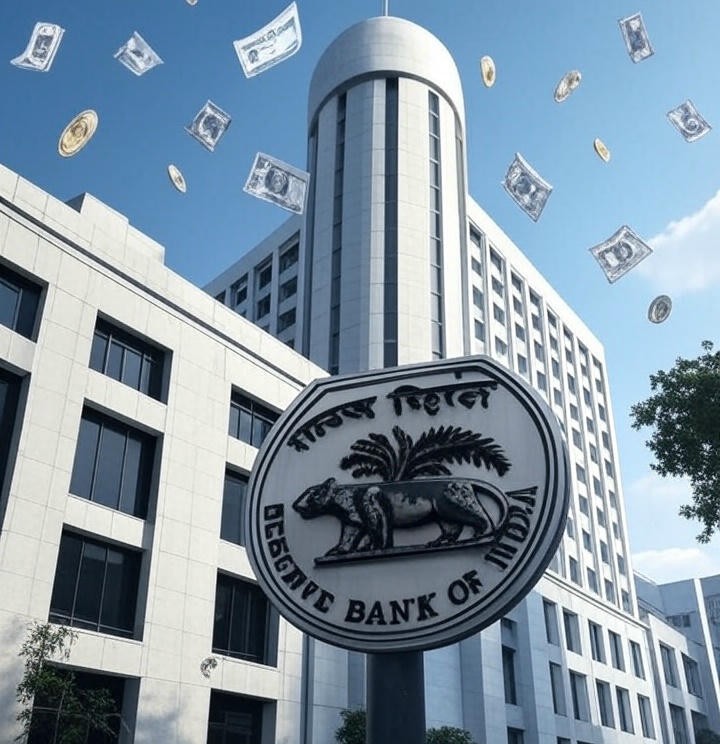In a major move to boost the Indian economy the Reserve Bank of India (RBI) has cut the repo rate by 50 basis points (bps) to 5.5% and reduced the Cash Reserve Ratio (CRR) by 100 basis points. This decision comes at a time when inflation has fallen to 3.2% the lowest level India has seen in the last six years.
But what does this mean for the common man, for businesses and for the overall economy?

What is the Repo Rate?
The repo rate is the interest rate at which the RBI lends money to commercial banks. When the repo rate goes down banks can borrow money at a lower cost. In turn banks are likely to reduce interest rates on loans given to the public including home loans, car loans and business loans.
So if the repo rate is lowered it becomes cheaper for people and companies to borrow money.
What is the CRR?
The Cash Reserve Ratio (CRR) is the percentage of a bank’s total deposits that it must keep with the RBI in the form of cash. This money cannot be used for lending or investments.
When the RBI cuts the CRR it means banks have more money in hand to lend. A 100 bps (1%) cut in CRR gives banks more liquidity which means more money is available in the system.
Why Did RBI Make This Move?
There are two main reasons behind RBI’s decision:
1. Inflation is at a Record Low
Inflation in India has come down to 3.2% the lowest in six years. When inflation is low it gives the central bank more freedom to cut interest rates. With prices of goods and services stable there is less fear that cutting rates will lead to price hikes.
2. Boosting Economic Growth
The Indian economy has been slowing down. Businesses are not investing enough and people are spending less. By cutting the repo rate and CRR the RBI wants to encourage banks to lend more. When loans become cheaper it can lead to more spending and investment which helps the economy grow.
How Will This Affect You?
Let’s look at how this move can impact different sections of the population:
1. Homebuyers and Loan Seekers
If you are planning to take a home loan or any other loan this is good news. Banks are likely to reduce their interest rates. This means your monthly EMIs (Equated Monthly Installments) could become lower. For example a 50 bps cut on a home loan of ₹30 lakhs could reduce your EMI by a few hundred rupees per month.
2. Small Businesses and Startups
Small businesses often depend on loans to grow. Lower interest rates mean cheaper credit. It will be easier and more affordable for them to borrow money, invest in their businesses and create jobs.
3. Stock Market and Investors
Rate cuts are usually good for the stock market. Cheaper money often leads to higher investment in equities. As businesses borrow and invest more their profits may rise attracting more investors.
Risks and Challenges
While the RBI’s move is largely positive it also comes with some risks:
1. Too Much Liquidity
Lower interest rates and higher liquidity can sometimes lead to too much money chasing too few goods. If not handled carefully it could push inflation up in the future.
2. Impact on Savings
If banks reduce the interest they pay on deposits savers may earn less. This can especially affect senior citizens who depend on fixed deposit interest income.
3. Transmission of Rate Cuts
Another challenge is the transmission of rate cuts. Sometimes even when the RBI reduces the repo rate banks do not pass on the full benefit to customers. This could reduce the effectiveness of the move.
Expert Reactions
Economists and financial experts have generally welcomed the RBI’s move. Here’s what some of them are saying:
- Dr. Raghuram Mehta economist: “This is a much needed step. With inflation under control the RBI is rightly focusing on supporting growth.”
- Anita Sharma, banking analyst: “Banks now have more liquidity and we expect a cut in lending rates soon.”
- Rajiv Kapoor business consultant: “This should boost consumer confidence and help revive demand in sectors like real estate and automobiles.”
What’s Next?
The RBI has also hinted that it may continue with an “accommodative policy stance.” This means that if inflation remains low and growth does not pick up the RBI could cut rates again in the coming months.
The central bank will also closely watch how banks respond—whether they actually lower interest rates and lend more—and how markets and consumers behave.
Conclusion
The RBI’s decision to cut the repo rate to 5.5% and reduce the CRR by 100 basis points is a strong step aimed at boosting the Indian economy. With inflation at a six-year low the timing is ideal to support growth through cheaper loans and increased liquidity.
If implemented effectively this move can lead to:
- Cheaper loans for individuals and businesses
- Higher spending and investment
- Revival in sectors like housing, retail and manufacturing
- Greater economic momentum in the coming quarters
But careful monitoring is needed to ensure inflation does not rise and banks actually pass on the benefits to consumers.
For now this is a hopeful signal from the RBI that the focus is shifting toward growth something that both businesses and citizens have been waiting for.
